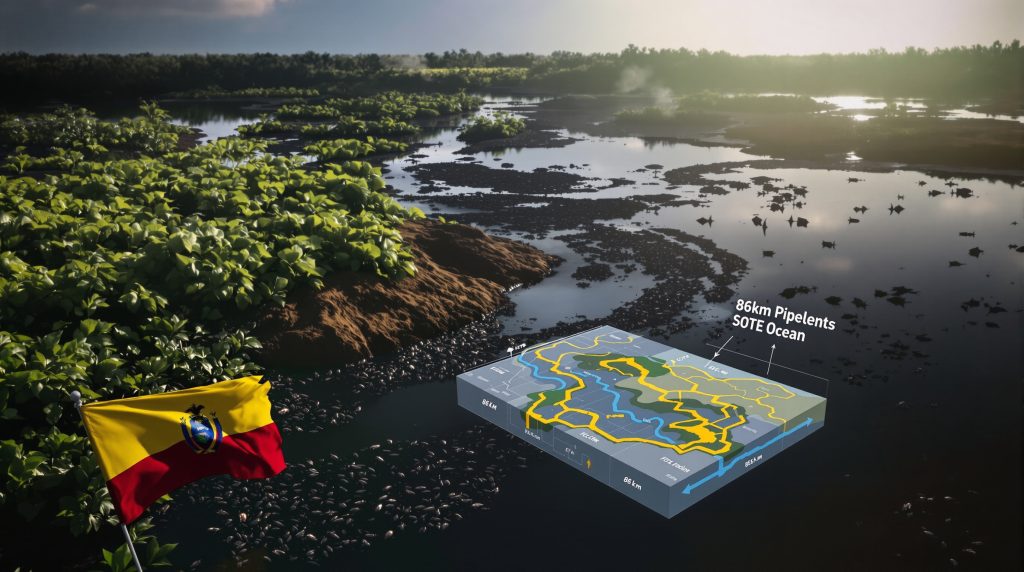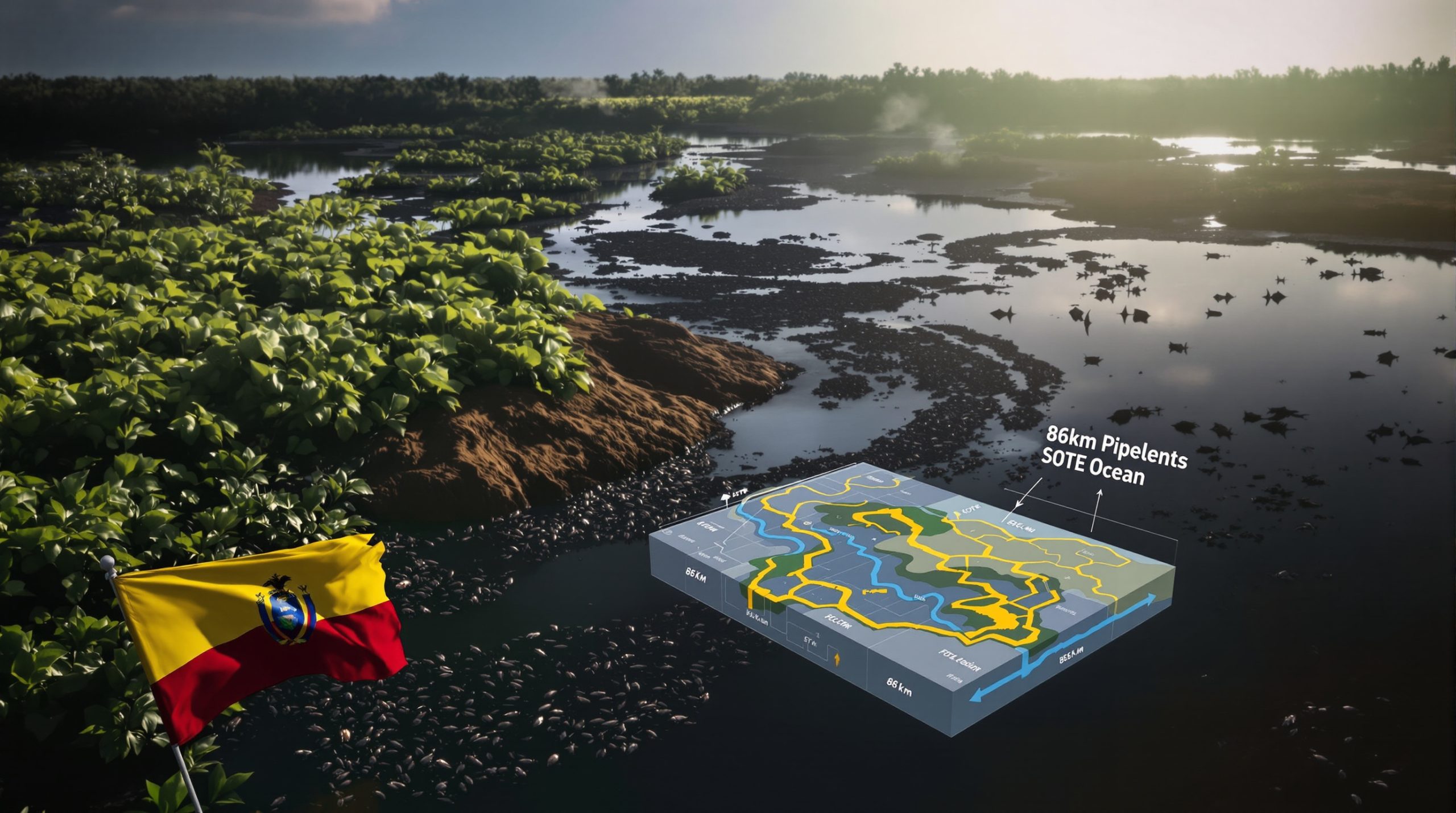What Caused Ecuador's Devastating Oil Spill in 2025?
The catastrophic event that struck Ecuador's oil industry in March 2025 originated from a rupture in the Sistema de Oleoducto Transecuatoriano (SOTE) pipeline near Quinindé in Esmeraldas province. This disaster, now considered Ecuador's worst environmental catastrophe in decades, stemmed from a perfect storm of factors. Unusually heavy rainfall triggered devastating landslides that destabilized the ground supporting the aging pipeline infrastructure, ultimately causing a breach that released approximately 25,000 barrels of crude oil into surrounding ecosystems.
The pipeline failure occurred during an exceptionally intense winter storm that had already caused significant flooding throughout the region. While initial statements from Petroecuador suggested potential sabotage, subsequent investigations revealed a more complex reality: chronic infrastructure weaknesses, years of deferred maintenance, and inadequate emergency preparedness all contributed significantly to the disaster.
Independent engineering assessments later confirmed that warning signs had been documented months before the rupture. Inspection reports had identified critical vulnerabilities in precisely the section that failed, but recommended repairs were repeatedly postponed due to budgetary constraints and operational priorities.
How Extensive Was the Environmental Damage?
Waterway Contamination
The environmental impact of the spill extended approximately 86 kilometers downstream, creating a toxic pathway through multiple interconnected waterways. From the rupture site, crude oil flowed into the Viche River, then the Esmeraldas River, before ultimately reaching the Caple Estuary and Pacific Ocean.
Water quality testing conducted by independent environmental monitoring teams revealed alarming levels of petroleum hydrocarbons and heavy metals throughout these systems. Concentrations of benzene, toluene, and xylene reached levels up to 300 times above safety standards in some locations, rendering these waters toxic to aquatic life and unsafe for human use.
Ecosystem Devastation
The environmental consequences have been particularly severe in the Esmeraldas River Estuary Mangrove Wildlife Refuge, a critical ecological zone. Here, the damage included:
- Thick oil coating mangrove root systems, suffocating these crucial coastal ecosystems
- Sediment contamination creating long-term toxicity in river and estuary beds
- At least nine beaches suffering significant pollution
- Mass die-offs of fish, crustaceans, and mollusks throughout the affected waterways
- Migratory bird populations losing critical feeding and nesting grounds
- Endangered species habitats being significantly compromised
Environmental scientists documented oil slicks extending several kilometers into the Pacific Ocean, threatening marine ecosystems far beyond Ecuador's coastline. Remediation experts estimate that full ecological recovery could take decades, with some damage potentially irreversible, particularly in sensitive mangrove areas where oil becomes trapped in complex root systems. The deep‐sea environmental controversy surrounding such disasters continues to grow as more evidence of long-term damage emerges.
How Did the Disaster Impact Local Communities?
Public Health Crisis
The spill triggered an immediate public health emergency across the affected regions, with impacts quantified in this assessment:
| Health Impact | Affected Population | Primary Cause |
|---|---|---|
| Respiratory illness | ~35,000 residents | Toxic fume inhalation |
| Gastrointestinal disease | ~42,000 residents | Contaminated water consumption |
| Skin conditions | ~28,000 residents | Direct contact with polluted water |
| Long-term exposure concerns | 500,000+ residents | Ongoing environmental contamination |
Women shellfish harvesters along the coast have been disproportionately affected, as they regularly wade into now-contaminated waters to collect their livelihood. Medical professionals report alarming increases in chemical burns, persistent rashes, and respiratory distress among these workers, with limited access to specialized healthcare.
Water Access Crisis
Approximately 500,000 residents lost access to safe drinking water as municipal systems drew from contaminated sources. Emergency water distribution efforts struggled to meet demand, with many remote communities experiencing severe shortages for weeks following the disaster.
The most vulnerable populations often waited days for emergency water deliveries, and many resorted to collecting rainwater or purchasing bottled water at inflated prices. Rural communities, particularly indigenous settlements with limited infrastructure, suffered the most prolonged water access issues, highlighting systemic inequalities in disaster response capabilities.
Agricultural Devastation
The economic impact on local agriculture has been severe and multifaceted:
- Over 60,000 acres of farmland contaminated by oil or irrigation with polluted water
- Crop destruction affecting primarily subsistence farmers with limited resources
- Livestock illness and death from consuming contaminated water and vegetation
- Fishing industry collapse in coastal communities dependent on marine resources
For many farming families, this represents not just an immediate loss of income but a long-term threat to food security and cultural practices that have sustained communities for generations. The need for effective waste management strategies has become even more crucial in the aftermath of this disaster.
What Was Ecuador's Response to the Crisis?
Government Actions
The Ecuadorian government declared an environmental emergency within 48 hours of the spill, mobilizing resources from multiple agencies:
- The Ministry of Environment deployed emergency response teams to contain spreading contamination
- Military personnel assisted with evacuation and emergency water distribution
- Health ministry established temporary clinics to treat exposure victims
- International assistance was requested for technical expertise and resources
Despite these efforts, critics noted significant delays in notification systems, with some communities receiving no official warning until oil had already reached their water supplies. The coordination between national, provincial, and municipal authorities was often fragmented, hampering effective response in the crucial early days.
Petroecuador's Controversial Response
The state oil company's handling of the crisis generated substantial controversy and public outrage:
- Initial public statements minimized the spill's severity, claiming containment within hours
- Subsequent blame-shifting to natural causes, then unsubstantiated sabotage claims
- Revelations of ignored safety inspection recommendations from previous years
- Inadequate emergency response equipment at critical pipeline junctions
- Delayed deployment of containment booms and skimmers
Independent investigations revealed that Petroecuador had deferred critical maintenance on the SOTE pipeline system despite documented warnings about vulnerability to landslides in precisely the area where the rupture occurred. Internal memos obtained by investigative journalists showed that budget cuts had reduced inspection frequency and postponed scheduled reinforcement projects.
How Has the Disaster Affected Ecuador's Oil Industry?
Production Disruptions
The March 2025 disaster compounded existing challenges in Ecuador's oil sector, creating widespread operational disruptions:
- Complete shutdown of the SOTE pipeline, which normally transports approximately 360,000 barrels per day
- Simultaneous closure of the OCP (Oleoducto de Crudos Pesados) pipeline due to related erosion concerns
- Combined capacity loss exceeding 800,000 barrels daily, representing nearly all of Ecuador's oil export capacity
- Production facilities forced to suspend operations due to inability to transport crude
These disruptions have created a cascading effect throughout Ecuador's energy infrastructure, with multiple facilities remaining offline months after the initial incident. Storage facilities reached capacity within days, forcing production wells to be shut in across the Amazon region.
Economic Consequences
The financial impact has been devastating for Ecuador's oil-dependent economy:
- Projected revenue losses exceeding 15% of annual government budget
- Emergency cleanup costs estimated at $300 million and rising
- International compensation claims from neighboring countries affected by oceanic contamination
- Investor confidence severely damaged, with foreign direct investment in energy projects declining
- Credit rating downgrades increasing borrowing costs for recovery efforts
The disaster has highlighted the vulnerability of Ecuador's economy to oil industry disruptions, renewing calls for economic diversification. With oil revenues representing approximately 40% of export earnings, the extended production shutdown has strained government finances and limited resources available for both environmental remediation and social programs. According to OilPrice.com's analysis, this represents the worst environmental disaster in the country's oil industry history.
What Are the Long-Term Implications for Ecuador's Energy Future?
Infrastructure Vulnerabilities
The 2025 disaster exposed critical weaknesses in Ecuador's energy infrastructure that demand urgent attention:
- Aging pipeline systems with average operational age exceeding design specifications
- Inadequate monitoring technology for early leak detection
- Insufficient emergency response capabilities in remote areas
- Vulnerability to increasingly extreme weather events linked to climate change
- Regulatory oversight gaps allowing deferral of critical maintenance
Engineering assessments conducted after the spill identified at least 23 additional high-risk segments in the country's pipeline network requiring urgent reinforcement or replacement. These findings have sparked debate about the sustainability of maintaining oil infrastructure in environmentally sensitive and geologically unstable regions.
Policy Reforms and Industry Changes
In response to the crisis, several significant policy shifts have emerged:
- Mandatory pipeline integrity management programs with independent verification
- Enhanced environmental liability requirements for operators
- Strengthened indigenous consultation processes for new infrastructure projects
- Accelerated investment in diversification toward renewable energy
- Restructuring of regulatory oversight with greater independence from industry
These reforms represent the most substantial overhaul of Ecuador's energy regulatory framework in decades, though implementation challenges remain significant. The disaster has created unprecedented political will to address longstanding issues in the sector, with civil society organizations playing a key role in advocacy for stronger environmental protections. As the sector evolves, industry innovation trends from other extractive industries are being applied to oil production.
How Does This Compare to Ecuador's Previous Oil Industry Disasters?
Historical Context
The 2025 disaster exists within a troubling pattern of environmental damage from Ecuador's oil industry:
- The infamous Chevron-Texaco contamination case, where decades of toxic waste dumping created a legacy of pollution in the Amazon region
- Multiple smaller pipeline ruptures throughout the 2010s and early 2020s that received limited remediation
- Persistent issues with illegal tapping and theft-related spills
- Ongoing contamination from routine operations affecting indigenous territories
What distinguishes the 2025 disaster is its scale, visibility, and impact on population centers rather than remote Amazon regions where previous contamination often received less attention. The proximity to coastal communities and tourist areas brought unprecedented media coverage and international scrutiny.
Regulatory Evolution
Each major incident has triggered incremental regulatory changes, forming a pattern of reactive policy development:
| Period | Major Incident | Regulatory Response | Implementation Effectiveness |
|---|---|---|---|
| 1960s-1990s | Texaco Amazon contamination | Minimal oversight | Extremely poor |
| 2000s | Various Amazon spills | Environmental management laws | Limited enforcement |
| 2010s | OCP leaks | Enhanced reporting requirements | Partial compliance |
| 2025 | SOTE rupture | Comprehensive regulatory overhaul | Ongoing development |
The 2025 disaster has generated unprecedented public pressure for meaningful reform, with international attention amplifying demands for accountability. Ecuador's 2008 Constitution, which includes pioneering "Rights of Nature" provisions, has provided a legal framework for environmental advocates to demand more substantive changes than previous incidents produced.
What Challenges Face Ecuador's Oil Spill Cleanup Efforts?
Technical Remediation Challenges
Cleanup teams face numerous obstacles in addressing the widespread contamination:
- Difficult terrain limiting access to contaminated riverbanks and estuaries
- Persistent rainfall continuing to spread pollution through watershed systems
- Limited availability of specialized equipment within the country
- Mangrove ecosystems particularly challenging to clean without causing additional damage
- Sediment contamination requiring extensive dredging and treatment
Environmental experts estimate complete remediation could take 5-10 years and cost upwards of $1 billion, far exceeding Ecuador's current budgetary capacity. The technical complexity of removing oil from mangrove systems presents particular challenges, as conventional cleanup methods often cause additional harm to these sensitive ecosystems. According to Amazon Frontlines, such remediation efforts are complicated by ongoing expansion of oil operations in the region.
Community Restoration Needs
Beyond environmental cleanup, affected communities require comprehensive support:
- Water infrastructure reconstruction and decontamination
- Healthcare monitoring for long-term exposure effects
- Economic assistance for displaced farmers and fishers
- Alternative livelihood development in areas where traditional activities remain impossible
- Psychological support for communities experiencing trauma and displacement
Coordinating these efforts across multiple agencies and NGOs has proven challenging, with significant gaps in service delivery to the most vulnerable populations. Indigenous communities, with distinct cultural needs and historical marginalization, face particular challenges in accessing appropriate support services.
What Lessons Can Be Learned From Ecuador's Oil Disaster?
Infrastructure Resilience
The disaster highlights critical lessons for oil-producing nations:
- Climate change adaptation must be integrated into infrastructure planning
- Preventative maintenance cannot be deferred, especially in environmentally sensitive areas
- Early warning systems require significant modernization to prevent cascading failures
- Emergency response capabilities must match the scale of potential disasters
- Independent oversight of industry self-reporting is essential
These lessons extend beyond Ecuador to other countries with aging oil infrastructure in environmentally vulnerable regions. The increasing frequency and intensity of extreme weather events globally make pipeline resilience a critical safety issue that transcends national boundaries. The importance of mine reclamation insights from other extractive industries has become increasingly relevant to oil production sites.
Environmental Justice Considerations
The pattern of impacts reveals important environmental justice dimensions:
- Indigenous and rural communities bearing disproportionate contamination burdens
- Limited voice in decision-making processes regarding infrastructure near their territories
- Inadequate compensation mechanisms for long-term livelihood impacts
- Unequal access to emergency services and remediation resources
- Intergenerational consequences of persistent environmental contamination
The 2025 disaster has catalyzed new coalitions between environmental organizations, indigenous rights groups, and public health advocates demanding more equitable approaches to energy development. These alliances have strengthened calls for meaningful consultation with affected communities before infrastructure projects are approved.
FAQs About Ecuador's Oil Industry Disaster
What caused Ecuador's oil pipeline to rupture in 2025?
The SOTE pipeline rupture resulted from a combination of extreme rainfall, landslides destabilizing the pipeline's foundation, and inadequate maintenance of aging infrastructure. While initial reports suggested potential sabotage, investigations revealed that environmental factors and deferred maintenance were the primary causes.
How many people were affected by Ecuador's oil spill?
Approximately 111,000 people were directly impacted by immediate contamination effects, while nearly 500,000 experienced disruptions to water supplies. The economic ripple effects have affected millions more through Ecuador's national economy.
What wildlife was most severely impacted by the oil spill?
Aquatic species suffered the most immediate impacts, with fish, crustaceans, and mollusks experiencing mass die-offs. Mangrove ecosystems, which serve as critical nurseries for marine life, sustained severe damage. Migratory birds and mammals dependent on the affected waterways also experienced significant habitat loss and contamination exposure.
How long will Ecuador's oil spill cleanup take?
Environmental experts estimate that full remediation could take 5-10 years for visible contamination, while complete ecosystem recovery may require decades. Some ecological damage, particularly in sensitive mangrove areas, may be permanently altered.
What economic impact has the disaster had on Ecuador?
The disaster has created projected revenue losses exceeding 15% of Ecuador's annual government budget, with cleanup costs estimated at $300 million and rising. The country has also experienced credit rating downgrades and decreased foreign investment in its energy sector.
Further Exploration
Readers interested in learning more about environmental challenges in Ecuador's oil industry can also explore related educational content on global energy industry developments and environmental impacts. The complex interplay between energy security, economic development, and environmental protection continues to shape Ecuador's national dialogue about its oil industry future.
Concerned About the Impact of Oil Disasters on Financial Markets?
Discover how mineral discoveries can provide alternative investment opportunities during oil sector disruptions by visiting Discovery Alert's discoveries page, where our proprietary Discovery IQ model analyses ASX announcements to deliver real-time alerts on significant mineral findings that could yield substantial returns.




